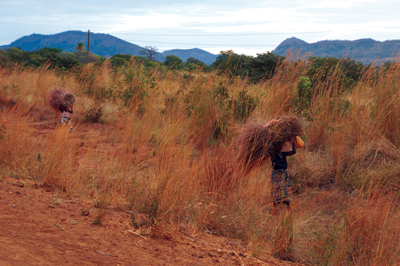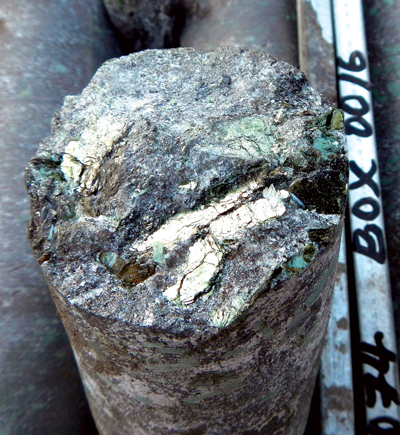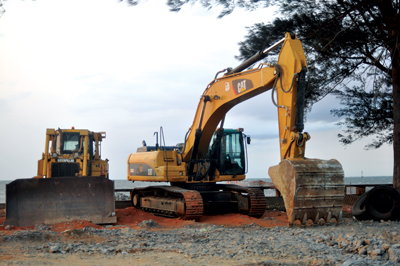 Syrah’s Balama North project, with the graphite hills on the left, granite to the right. (Photo courtesy of Syrah Resources)
Syrah’s Balama North project, with the graphite hills on the left, granite to the right. (Photo courtesy of Syrah Resources)Increasing demand and Chinese mine closures spur activity around graphite projects in Mozambique and Madagascar
By Gavin du Venage, South African Editor
Mining legend Robert Friedland likes to point out that if the world is going to sustain its push to green technologies, it will need specialist minerals. Graphite is one of them and southeastern Africa is home to some of the largest untapped deposits in the world.
Rare earths, copper, lithium and platinum are among the elements expected to help the world make the transition to a reduced dependency on fossil fuels.
It’s graphite, though, that is the basis for lithium-ion batteries that power everything from laptops to smartphones and increasingly, electric cars. It’s used to make the anodes of a lithium-ion battery, without which the battery couldn’t function.
Batteries are not usually headline-grabbing items, but the surge of interest in Tesla Motors and its premium lithium-ion-powered premium vehicles have raised its profile to stratospheric heights. Telsa’s rock star CEO Elon Musk has pledged to build a “Gigafactory” that will produce 35G Wh of cells and 50G Wh of packs per year by 2020.
This will consume 83,000 metric tons (mt) of flaked spherical graphite, about half of current global production, according to Simon Moores, a London-based senior analyst at Industrial Minerals Data in London.
At the moment, most of the world’s graphite comes from China’s east coast. However, the mines have become an environmental flashpoint for Beijing, which has begun to crack down on polluting operations. Last December, up to 55 miners and processors of graphite in the town of Pingdu in Shandong were closed by the local government for failing to improve wastewater, dust and gas emissions.
Shifting Supply Patterns
More closures are expected in China as inspections continue and the result could push up prices by 30% in the coming year, according to Moores. This comes as Chinese demand for the mineral to supply its own manufacturers is growing.
“Most interesting to note is that China is stepping up as a consumer of foreign sourced flake graphite when it is used to sourcing from its own producers,” Moores told E&MJ. “We could be seeing the start of a switch of global supply patterns.”
North America and Canada in particular are the focus at the moment, but a clutch of junior projects in Tanzania and Mozambique, where some of the world’s largest untapped deposits are found, are also worth keeping an eye on.
“Africa has some of the highest quality graphite projects in the world,” Moores said. “While the risks are well documented, you have to look at huge economies like China that are desperate to secure long-term resources outside of their own borders. Natural resources can be seen as a new form of global currency and China is using its cash to buy up the most. The need for new graphite mines also makes these lower cost mining areas attractive.”
A series of promising deposits stretches from Mozambique’s Cabo Degado province to the north of the country, extending across the border to Tanzania all the way up to Kenya. The Indian Ocean island of Madagascar could also become a significant graphite play.
The Chinese Connection
The largest graphite prospect is under exploration license and mining lease to Syrah Resources, an Australian-listed company. Syrah’s huge Balama project in Mozambique contains an estimated 117 million mt of graphite—more than the rest of the world’s graphite reserves combined, as well as vanadium.
“Mozambique graphite has been known for 40 years to be of exceptionally high quality,” said Tom Eadie, Syrah’s chairman. “Madagascar and Tanzania have some up and coming deposits too. The east coast of Africa has an 800-million-year history of organic rich sediments being deposited into rift basins. These carbon rich sediments quickly become buried to great depths. The heat, pressure and shearing in this environment is perfect for making graphite out of the carbon through metamorphism.”
In March, Syrah signed a Memorandum of Understanding (MoU) for an offtake agreement with China Aluminum International Engineering Corp. Ltd. (Chalieco) for 80,000-100,000 mt/y of flake graphite and an amount of greater than 98% V2O5 chemical powder or flake products to be determined.
The standout feature of the MoU is its size, Moore noted: “80,000 to 100,000 mt is one hell of a lot of flake graphite for one company to take. In today’s world, the largest consumers take around 20,000 mt/y. This single deal represents 27% of the flake graphite market in 2013, which gives you an idea of its size.”
It’s the Chinese connection that has, in particular, made investors take note. While still heavily dependent on domestic producers, Chinese consumers are clearly on the hunt for alternative resources that could indicate a change in global supply patterns.
Previously, the biggest offtake had been that of Canada-based Focus Graphite, which announced a minimum of 20,000 mt/y deal with an unnamed Chinese industrial player over a 10-year period, about 50% of its planned output. This was the industry’s first offtake agreement and is also a lot of output to bank with one customer, Moores said.
Most of the offtake will be headed for the aluminum industry that uses around 20 million mt/y of carbon products. Chalieco will use some of the graphite for this but will also supply many other Chinese graphite consumers with Syrah’s product, Eadie said.
 Sample core from Balama North showing coarse graphite. Southeastern Africa has some of the highest quality deposits in the world. (Photo courtesy of Syrah Resources)
Sample core from Balama North showing coarse graphite. Southeastern Africa has some of the highest quality deposits in the world. (Photo courtesy of Syrah Resources)Pressing Ahead with Graphite Projects
In the meantime, Syrah will press ahead with its Balama project, a 111-km2 mining concession located within the Balama District in the Cabo Delgado Province, in northern Mozambique.
Last December, the Mozambican government granted Syrah Resources a 25-year mining license, for both graphite and vanadium at Balama.
Recent ASX-reported test work by an independent European potential customer got the following result from Balama East (more than 200 million mt at more than 16% graphite) from simple flotation, with no acid wash needed.
The company said 24% of the graphite was jumbo flake, which is 50 mesh or a little less than 300 microns at a grade of 98.2% C; in addition 33% of the graphite was coarse flake, which is 80 mesh (177 microns) at a grade of 97.5% C; 27% was medium flake, which is 140 mesh or (105 microns) at a grade of 97.6% C and 17% was fine flake.
“These results are phenomenal and unmatched by anyone else,” Eadie said. “Syrah can produce as much graphite at any flake size as the world needs at the highest purity.”
He added that Syrah was looking further north as well. “Syrah also has an excellent graphite project at Nachingwea in Tanzania, which will get a lot of focus in the next few months because we believe that it may be second to Balama in quality,” Eadie said.
Close by to Syrah’s projects is Triton Minerals’ diggings. Triton has three projects under way but is focusing on Balama North, which is located approximately 230 km west of the port city of Pemba, in northern Mozambique. It’s less than four kilometers from Syrah’s Balama and is showing similar resource results—Triton has found significant mineralization over a 10-km-long stretch featuring high-grade flake.
Drilling began a year ago and Triton is pushing the pace, said Brad Boyle, Triton managing director. “We are being quite aggressive and looking for as quick a result as possible. Our diamond rigs are drilling 24/7 because their drill pace is very slow. We’re trying to speed up the drill program and get as much done as we can before the wet season starts again in late November.”
According to Triton’s research, the company could potentially be the fourth largest producer in the region, with a 103-million-mt inferred resource. “Currently, we’re doing a drill program on Nicanda Hill; early indications from the drill program on Nicanda Hill, within the Cobra Plains deposit that in turn falls within Balama North, show that it could be one of the largest graphite deposits in the world, if not the largest,” Boyle said. “Numbers are looking very sizeable, and we’ve already proven up a mineralization zone that is about 1 km wide and could be up to 6 km long—it has grades in excess of 25%.”
A big advantage of the region’s deposits is that they can be processed without acid—a big contributor to pollution in China’s graphite producing regions. Neither Syrah nor Triton envision needing acid leaching to process their graphite.
The region has pretty decent infrastructure too. “I was astounded how good the road is,” said Boyle. “It gets serviced regularly and potholes fixed after the rainy season. You add to that an existing deepwater port, telecommunications and lots of local labor, and you have basic infrastructure that makes a world of difference.”
Boyle added that although talks have been held with Syrah over sharing infrastructure, nothing has been decided.
 Roadworks in Mozambique. Infrastructure around Mozambique’s graphite deposit is being upgraded and regularly maintained. (Photo by Gavin du Venage)
Roadworks in Mozambique. Infrastructure around Mozambique’s graphite deposit is being upgraded and regularly maintained. (Photo by Gavin du Venage)The Race to Production is on
The island of Madagascar in the middle of the Mozambique Channel also has a contender for a mega graphite project: Canadian-listed Energizer Resources. The company’s flagship Molo deposit on the southern part of the island has an 84 million mt indicated resource and has advanced to full feasibility stage. Energizer has a pilot plant up and running that has generated 12 mt of finished graphite concentrate that will be made available to potential strategic partners.
Also wanting a piece of the action is Kibaran Resources with its Mahenge project that lies within a historically recognized graphite occurrence in southeast Tanzania. The company has an inferred JORC resource of 14 million mt, enough to secure a guarantee for the purchase of 10,000 mt/y of graphite concentrate from an unnamed European trader, according to the company’s website.
Mahenge hosts the Epanko deposit and is now the primary focus for Kibaran.
This does pose the question of whether this town is big enough for all the potential producers. With so many contenders moving in on the graphite space, it’s likely that some will fall by the wayside.
In all likelihood, it will come down to who manages to tie up agreements with buyers and crucially, who gets their spade in the ground first.
“I think more offtake deals will follow in 2014 and 2015, but actual production is king,” Moores concluded. “The race to be the first into production is on.”









